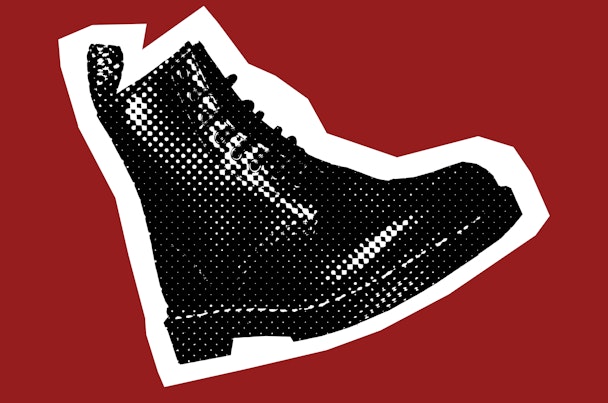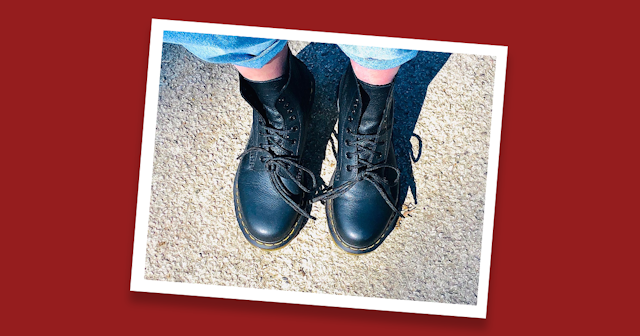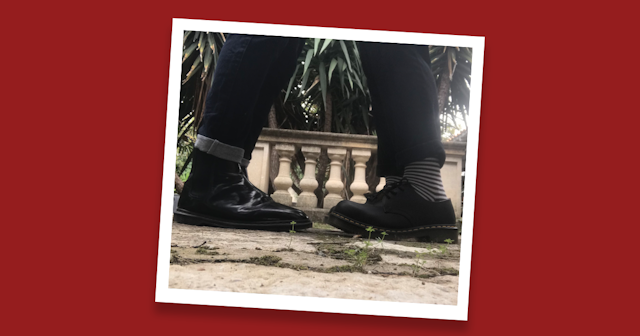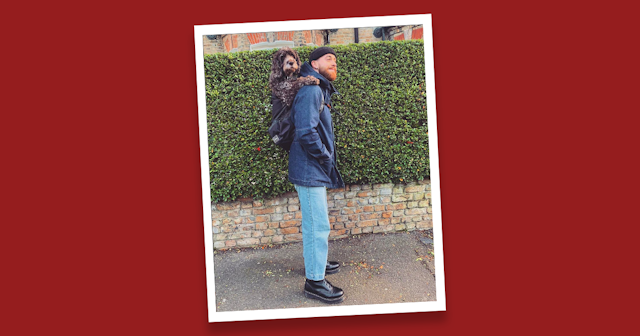
Advertisement

Stock image of DMs, photoshopped with a halftone effect
British brands Dr Martens and Brewdog plan to trade on alternative credentials at the stock market. While aggressive expansion might threaten their countercultural cachet, DTC channels, sustainability and fervent brand advocacy can help them stay punk.
Chloé Templeman was eight years old when she received her first pair of Dr Martens. “I think it was ‘91. My dad was a bit of a punk and a rebel. Considering he worked on the rigs as an electrician – a proper Fifer – he really experimented with his clothes. I remember him bringing the boots in and telling me that it’s like ‘walking on air’,” she recalls.
“They weren’t, but I thought I was the coolest kid in the world. I probably was. I used to wear them to school and even though they really hurt, I thought I was the shit.”
Templeman, creative director at London agency Design Bridge, is still a DM devotee. And these days, she’s not the only one.
The beloved British bootmaker makes for an unlikely stock market bet. Its flagship silhouette boots are talisman pieces that have to be broken in, and while they are a favorite of mods and punks past and present, they’ve also been associated with far right skinheads.
But the brand, which has gained ground since narrowly avoiding bankruptcy at the beginning of the century, has just floated on the stock market in the biggest IPO for any British company since September. As the business continues to expand, can it keep its place in the counterculture, or will it get too big for its boots?
Though Dr Martens’ distinctive design has its roots in post-war Germany, its spiritual birth was the mod rock scene of the 60s, when musicians such as The Who’s Pete Townshend discovered their utility for stage-stomping. The boots – originally marketed to postal workers, builders and police officers – later became a punk staple, and by the 90s, had entered the mainstream. According to designer Marc Jacobs, quoted in a 1992 style column in The New York Times: “It’s the symbol of the downtown bohemian with somewhere to go.”

It’s also a brand that inspires devotion among fans. Daniela Meloni, design director at London-based FutureBrand, recalls her first pair. “My auntie went to London for a holiday; she was a bit eclectic. And she bought me my first pair of Dr Martens in Camden. I was beyond myself when I received the boots, back in rural Sardinia. I was the coolest girl.”
For Meloni, the brand has been a constant companion. “I feel like Dr Martens has been following me all my life.”
Dr Martens, which declined to comment for this story, almost went under in the early 2000s, before a turnaround and eventual buyout by private equity firm Permira in 2013. While the company pledges it’s not tweaked the boots’ design, it now markets itself to alternative-minded fashion consumers rather than posties and police. In fact, the retail price of its flagship boot is now 11,850% higher than when they debuted in 1960; a bigger increase than the average price of a British house, one ounce of gold or a barrel of oil, according to Quartz.
“There’s a wave of people getting DMs at the moment,” says Templeman’s Design Bridge colleague, design director Alice Douglas-Deane – who also received her first pair as a child. “As a brand, they’re so part of the fabric of the UK. They’ve always been there, but they keep moving with the times.”
Vanella Jackson is chief executive officer at Hall & Partners, a strategic brand consultancy owned by Omnicom. Though she hasn’t owned a pair of Docs since her gig-going days, Jackson says consumers “don't really care” about the stock market, but that they will notice if the business changes direction.
“It depends on their strategy to grow. Generally, the brands that have success at their heart are the ones that stick to their roots.”
Having worked on BBH’s Levi's account during its ‘Laundrette’ heyday, Jackson warns against Dr Martens letting its current fashionable status go to its head. “[Levi’s] chased fashion and they forgot the quality of the product and its heritage. It began to lose its relevance. There’s obviously a similar parallel here,” she says, noting that by keeping on its toes, Dr Martens can avoid a similar fate. “At the beginning [Dr Martens] was all about tradition and authenticity. But it’s managed to constantly reinvent what that means.”
Dr Martens is not the only British brand hoping to use its punk image as a platform for global success. Scottish beermaker Brewdog is preparing for its own entry to the stock market ahead of an international push; at its latest and last crowdfunding effort, it raised £1.2m ($1.6m) in 48 hours.
It too has benefitted from an association with punk, but the brewer’s claim is substantially weaker than the bootmaker’s, fueled by reactive social media work and eye-catching out-of-home creative. Will its astroturf credentials fly with international markets?
Jackson suggests consumers don’t mind. “I’m still drinking it, and I haven’t been a punk for a very long time,” she says. “The biggest struggle for brands is getting your head above the parapet and being noticed. If you’re on to something, stick with it, rather than trying to water it down.”
Underground talisman status can be a double-edged sword for consumer fashion brands, especially if a marque is adopted by the wrong subculture. Fred Perry, for example, recently took action to protect its brand by discontinuing product lines after its black and yellow polo shirts became the uniform of the alt-right Proud Boys (designated a terror group in Canada). In its time, Dr Martens has survived adoption by skinheads; as recently as 2017, the brand was criticized for a billboard in Portland, Oregon that featured red laces on black leather, an arrangement that the Southern Poverty Law Center classifies as a symbol of white supremacy.
But according to Jackson, Dr Martens’ focus on personal style has helped prevent its brand becoming tainted. “They’ve been very personalized and very targeted in their marketing, and they haven’t compromised the quality of the product at all along the way. So they haven't compromised their values or their integrity, but they’ve interpreted it to meet different people’s needs.”

Céline Mornet-Landa and Clément Mornet-Landa, creative directors at Sid Lee Paris, have been wearing Docs “forever”.
“We were teens during the grunge era. You had a different relationship with your shoes and clothes – you had a unique look, and they aged with you. We sometimes talk about a second skin, but here, it really was the case.”
“I lived in the south of France, so there were only one or two stores that sold Dr Martens, and only in black or red. At the London store you could get whatever you wanted (in this case, a pair of Crazy Horse – classic),” says Clément.
“Back when there was less of a sense of globalization; buying Dr Martens in London was like eating a pizza in Naples – you had the impression that it felt different.”
Since its turnaround, Dr Martens has sought to connect to consumers directly with e-commerce and over 130 brick and mortar stores. The strategy enables it to maintain the exclusivity Clément praises and has helped it weather the pandemic. It also mirrors the approach of Brewdog, which operates its own city centre bars and a digital e-commerce channel that co-founder James Wyatt credits with helping the business survive a year of shuttered pubs.
Jackson says: “It’s a trend that’s been accelerated through coronavirus. It’s the opportunity to have a one-to-one relationship with your customer and have that data as well, so that you know more about who they are, what their interests are, everything about them. That opportunity to get the right product, perfectly tailored and personalized to an individual, is only going to grow. Any brand that isn’t looking at that is going to miss the tide.”

With its boots famously sturdy and a vegan leather line already out, Dr Martens is well-placed to cater to another cresting trend: sustainability-oriented consumers. Brewdog, meanwhile, declared itself carbon negative back in September.
The selling point is a strong one for ad agency brand fans, such as Laura Vancil, a senior copywriter at TBWA\NY. “They’re timeless, durable, and they don’t really fall under a neat gender category, which I like. It might be the only overlapping wardrobe piece I could have with my dad. You can wear them to a concert, a client meeting, a hot summer day or in a blizzard,” she says.
M&C Saatchi Sport & Entertainment’s creative services manager Philippa Roffey, says her boots are “still going strong” after years of wear in and out of the office.
That argument persuaded her colleague Simon Wellbelove, a senior designer at M&C, to join the Dr Martens movement – though he’s not quite an advocate yet.
“I decided to grow up and buy a pair of good shoes for winter that I could actually keep for life. Everyone keeps telling me the pain is worth it,” he says. “I’m still waiting to find out.”